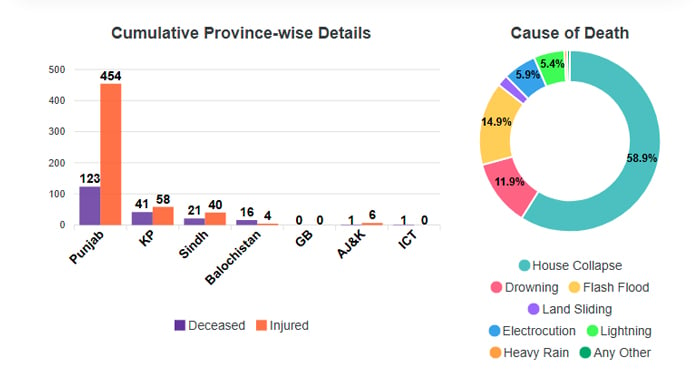- Wide-ranging impact-based weather alert warns of potential flash floods, urban inundation, and glacial water surges from July 19 to 25
- Punjab reported 123 deaths so far, KP recorded 40, Sindh 21, Balochistan 16, and Islamabad and AJK reported one each
ISLAMABAD: At least 202 people, including 96 children, lost their lives in various rain-related incidents since the start of the monsoon season in late June across Pakistan, while the National Emergencies Operation Center (NEOC) has issued another wide-ranging impact-based weather alert, warning of potential flash floods, urban inundation, and glacial water surges from July 19 to 25, (Saturday to Friday).
According to the National Disaster Management Authority’s (NDMA) NEOC on Saturday, the alerts cover vulnerable districts in Khyber Pakhtunkhwa, Punjab, Sindh, and Islamabad, where heavy rains are expected to disrupt daily life and pose serious risks to low-lying and mountainous communities.
According to the NDMA data, Punjab topped the monsoon death toll with 123 deaths, Khyber Pakhtunkhwa recorded 40 deaths, Sindh 21, Balochistan 16, and Islamabad and Azad Jammu and Kashmir reported one each.
The causes of death varied widely, with at least 118 killed due to house collapses, 30 from flash floods, and others due to drowning, lightning strikes, electrocution, and landslides, the NDMA report said.

The rains have injured more than 560 people, including 182 children, it said.
On the other hand, the NDMA has directed disaster management authorities to remain on high alert, expedite drainage clearance, and prepare emergency teams for rapid response. Citizens are strongly advised to avoid high-risk travel, remain indoors during intense downpours, and follow official guidance via the NDMA Disaster Alert App.
The alerts cover potential flash floods and urban flooding across different regions of the country, including Khyber Pakhtunkhwa, Punjab, and Sindh.
In Khyber Pakhtunkhwa, low to moderate rainfalls are expected to continue up to July 25, with an increased risk of flash flooding in the upper catchments of major rivers. River Kabul at Nowshera and its tributaries, such as the Swat, Panjkora, Bara, and Kalpani Nullah may experience rising water levels due to glacial melting and rain-induced inflows. There is a heightened flood risk in low-lying areas and disruption in transportation, especially in hilly and mountainous regions.
In Islamabad and Punjab, strong monsoon currents are expected to penetrate central and upper regions from July 21 to 24, bringing moderate to heavy rainfall across Rawalpindi, Lahore, Sialkot, Sargodha, Faisalabad, Multan, Khanewal, Sahiwal, Lodhran, Muzaffargarh, Kot Addu, Taunsa, Rajanpur, Bahawalpur, and Rahim Yar Khan.
Urban flooding is anticipated in major metropolitan cities due to heavy downpours, especially in low-lying zones.
Sindh is forecast to receive low to moderate rainfall and thunderstorms between July 19 and 24, affecting districts such as Karachi, Hyderabad, Sukkur, Jacobabad, Thatta, Badin, Larkana, Jamshoro, Nawabshah, and Mirpurkhas. Urban flooding may occur in low-lying areas, streets and underpasses.
The NDMA has urged authorities in vulnerable areas to swiftly clear drainage systems and ensure emergency teams are fully equipped to handle any eventuality.
The public is urged to remain indoors during periods of intense rainfall, keep drainage outlets clear, and safeguard essential household items.
Damage to infrastructure and property
In Rawalpindi, flash floods swept through homes, streets, and markets, submerging entire neighborhoods such as Dhamial, Hathi Chowk, and Morgah, the NDMA reported.
In Tench Bhata and Fauji Colony, water levels rose dangerously — in some areas reaching rooftops—forcing residents to flee, leaving behind their belongings.
Among the victims was eight-year-old Hasan Ali, whose grieving father described the family’s shock over the sudden loss.
Faisalabad has also witnessed extensive damage, with 11 deaths and 60 injuries reported in 33 incidents over just two days. Most of the fatalities occurred due to the collapse of weakened structures. Many of the affected families stated they lacked the resources to repair their homes before the monsoon.
Heavy rainfall and landslides have destroyed infrastructure across Punjab as the flood triggered by over 450mm of rainfall washed away 32 roads in Chakwal alone, while Rawalpindi also suffered heavy losses, especially to private property and businesses.
In nearby villages like Khewal, house collapses killed multiple people, including a father and son. Communication links remain severed, and the power supply is yet to be restored in several regions.
Rescue and repair work is underway. On the chief minister’s instructions, heavy machinery has been deployed to reopen blocked roads in Jhelum, Pind Dadan Khan, Kallar Kahar, and surrounding areas.
In Rawalpindi’s Karoli Dhoke Bridge area, a rain-triggered road breach has been patched to resume traffic flow.























